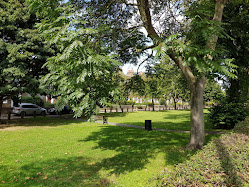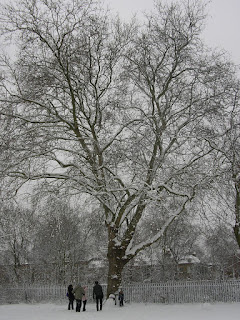Tree planting and care
Planting and looking after trees
The map below shows the number and huge diversity of types of trees on the Common.
Trees
help us in so many ways. They are vital to the air we breathe, help
offset air pollution, absorb and reduce air and noise pollution, provide shade and habitat for birds, insects and other creatures.
1998 saw the first tree planting in this current 'wave'. Four London Plane trees, a hornbeam and a field maple were planted by the Tree Musketeers, and local residents. Sadly two died, as in the early days we did not realise just how much water young trees need, nor that they needed protection from dogs!
Since then about 100 trees have been incrementally planted by a partnership of the Tree Musketeers, SNUG volunteers and Hackney's Parks and Arboricultural Department. Also our after-care knowledge has improved immensely. Indeed we are in the lucky position of not really having space for any more trees.
 |
| Early days - new trees |
And now!

As well as tree planting days, SNUG holds work days over the year to water and tend trees as necessary. Contact us for futher details.
However, although the Common now has a healthy stock of trees, it is a small urban park: trees are quite fragile and each one is precious.
Breaking branches, or stripping bark, introduces disease and deprives a tree of nutrients and so eventually kills the tree.
Sometimes people get their dogs to tear the tree bark. Unforunately many trees we planted over the years have died after the bark was stipped off by people or poorly trained, or badly treated dogs.
The
pictures above are of Sanford Terrace before extensive hedge and tree
planting,
and the pictures below were taken from the same spots now.

Many of the trees on the Common are commemorative.
A maple (Acer Rubrum Freemanii Autumn Blaze) and a 'Taiwan' cherry tree (Prunus Okame) were planted in honour of two SNUG members who died in recent years: Mahbub Miah and Cheryl Grey, respectively.
In 2009, an Atlas Ceder tree was planted and a plaque
erected to commemorate the struggle to end the Atlantic African slave trade.
Stoke
Newington was home to many local Quakers and others who campaigned against the
slave trade until it was finally made illegal in 1833. Joanna Vassa, the
daughter of Olaudah Equiano (who wrote about being enslaved and campaigned for the abolition of
slavery), is buried in Abney Park cemetery, as are many other abolitionists.















